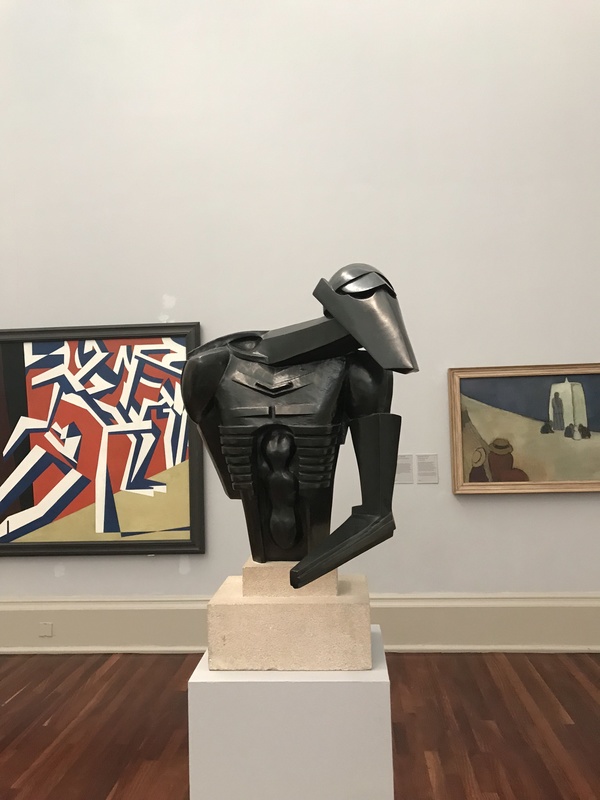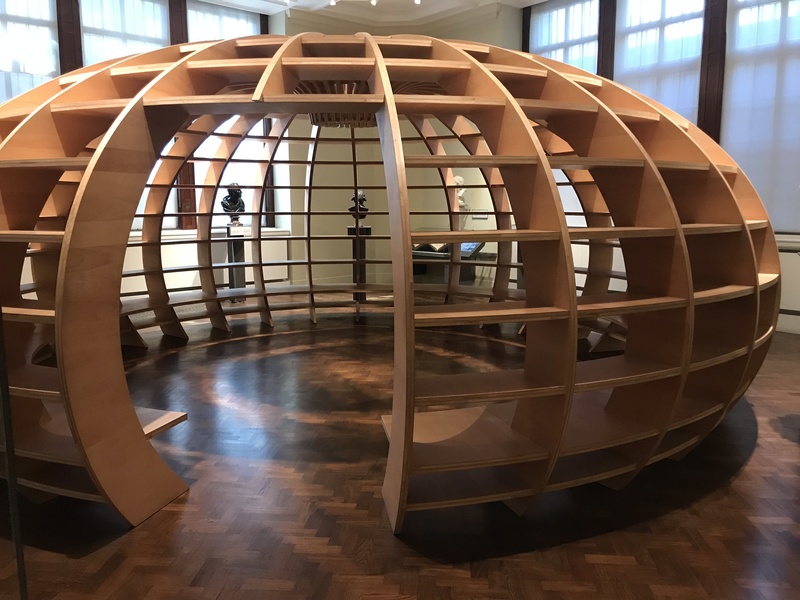Statuesque Protests
For Torso in Metal from 'The Rock Drill,' Epstein had originally set a plaster figure of this piece on top of a real industrial rock drill, creating a robot with a machine-like element. This piece at the time was a symbol of the new age dawning. This is what Epstein was going for but when he started hearing news of the casualties fro the 'mechanised warfare' of World War I. At this point Epstein removed the drill and dismantled the figure from the waist down. He then cast the remaining figure in bronze; transforming it from a menacing symbol of the new age, to a mutilated, vulnerable, victim to the violence it once symbolized.
Babel is a tower of radios, all tuned to different stations and at the lowest volume possible. The tower is structured with the older, larger, more furniture type of radios at the bottom of the tower, and the smaller, more modern radios on the top of the tower. The tower has an eerie effect from the competition heard in the room and the dark walls supported by blue lighting. The competition that the radios are giving off leads to a lack of comprehension for the audience. This incomprehension and the name Babel relates to the idea of babeling and I see it as a comment on the culture of talking to fill the silence as opposed to talking to communicate. The tower and its name also has a biblical relation to the story of a tower reaching to the heavens being created by people speaking all different languages.
Flag I is a piece of fabric that was used to clean blood off the street at the site of violent deaths related to drug cartels in Mexico, that has been hung on a flagpole in order to symbolize what flags, and nations, are truly standing for in this day and age. The fabric was hung outside of the Mexican pavilion as a memorial for the citizens lost as they and the drug wars were ignored by the Mexican government.
The Globe is (like its name would suggest) a globe-like wooden sphere, that allows people to walk in and around it. This piece can be interpreted in different ways. Many see it as a type of bookcase depicting the access to knowledge and how it opened up in the enlightenment. This interpretation works well in its current location in the Europe 1600-1800 gallery at the V&A Museum, as it is in the period of the Enlightenment in the museum. Another interpretation links The Globe to the style of prison created by Jeremy Bentham, where the cells were arranged in a way so that a guard could sit in the middle and observe all of the prisoners at once. This piece can be seen as both of these at the same time; and that’s how I choose to see it; the wisdom and knowledge gained from the enlightenment paired with the prison the people that people who weren’t able to access that knowledge were in, and are still to this day in.
All four of these sculptures have something to say about society. Specifically, they all have a critique of society to display, whether its present day society, a specific event that happened in society, who’s lesson can be applied to this day, a different society who’s message can be seen in other societies, or a comparison of society’s across time. Torso in Metal from the “Rock Drill” comments on the mechanised warfare used in World War I. But we still use mechanised warfare, and use more advanced technologies in war today that add to the disconnected way of taking human lives that Epstein was trying to comment on when he cut the plaster down at the waste all those years ago. Babel, as the name suggests comments on the babeling nature of society through the years. The older radios take up more space but the newer radios make more noise. This is a commentary on how society has evolved over the years by looking at this everyday object throughout the years. Flag I comments on the government's lack of action during the drug wars that has led to innocent lives being lost. In a way the government ignoring its people is like the warfare of World War I not distinguishing civilians from soldiers. The Globe comments on the sexism and racism that is present in our society and has been present for all of history. The lack of access to knowledge, given to minorities in the Enlightenment has led to a game of catch up that our society has been having to play ever since. All of these sculptures work to promote a specific agenda, and do so using their unmoving forms to imply the unwavering beliefs of their creators who took the time to make their protest a permanent piece of art.
-Julianne Falls



